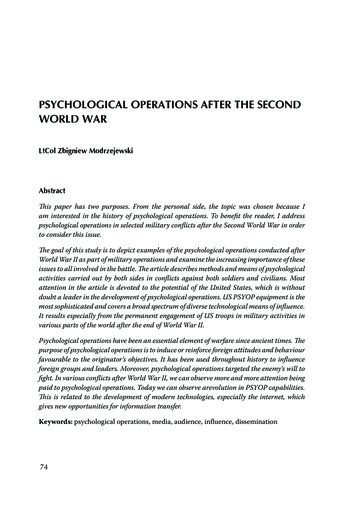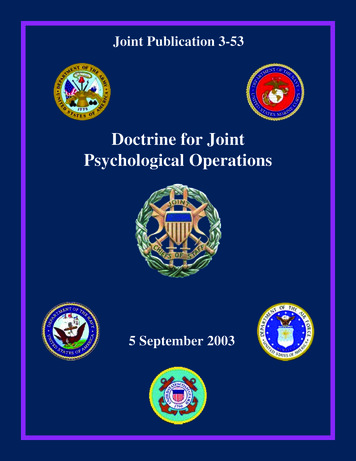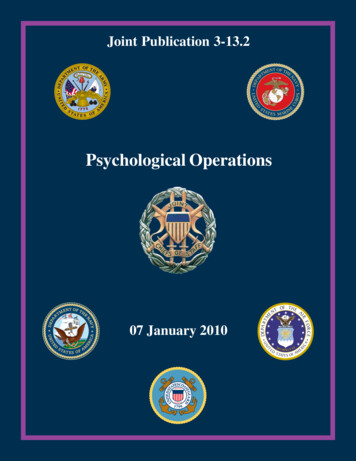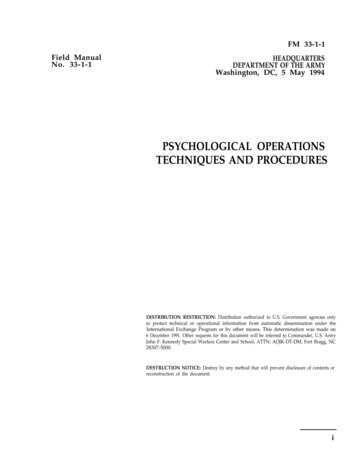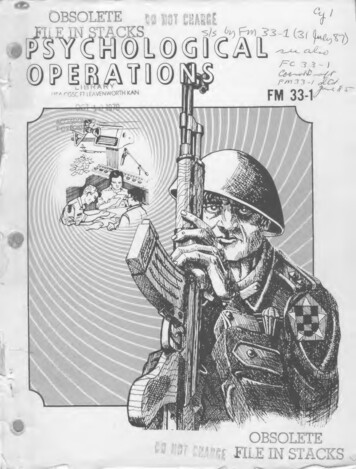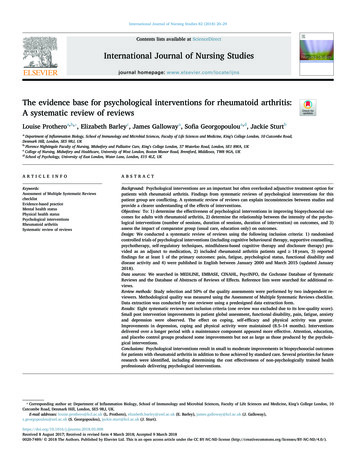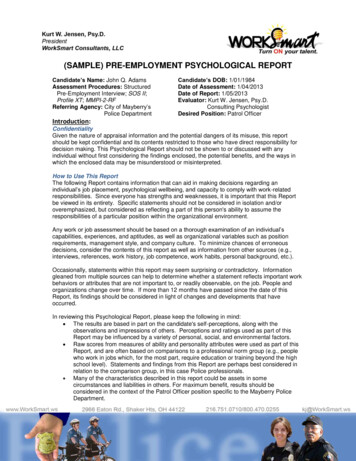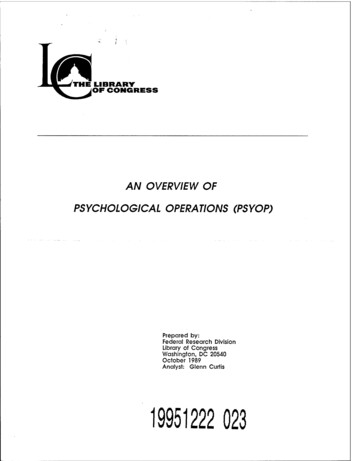
Transcription
THE LIBRARYOF CONGRESSAN OVERVIEW OFPSYCHOLOGICAL OPERATIONS (PSYOP)Prepared by:Federal Research DivisionLibrary of CongressWashington, DC 20540October 1989Analyst: Glenn Curtis19951222 023
Form ApprovedOMBNo. 0704-0188REPORT DOCUMENTATION PAGEPublic reporting burden for this collection of Information Is estimated to average 1 hour per response, Including the time for reviewing Instructions, searching existing data sources,gathering and maintaining the data needed, and completing and reviewing the collection of information. Send comments regarding this burden estimate or any other aspect of thiscollection of information, Including suggestions for reducing this burden, to Washington Headquarters Services, Directorate for Information Operations and Reports, 1215 Jefferson DaviHighway, Suite 1204, Arlington, VA 22202-4302, and to the Office of Management and Budget. Paperwork Reduction Project (0704-0188). Washington, DC 20503.1. AGENCY USE ONLY (Leave Blank)2. REPORT DATE3. REPORT TYPE AND DATES COVEREDOctober 1989Final4. TITLE AND SUBTITLE5. FUNDING NUMBERSAn Overview of Psychological Operations (PSYOP)6. AUTHOR(S)Glenn Curtist «IS7. PERFORMING ORGANIZATION NAME(S) AND ADDRESS(ES)DTIC &3kDEC 2 7 1995 . f8. PERFORMING ORGANIZATIONREPORT NUMBERFederal Research DivisionLibrary of CongressWashington, DC 20540-52209. SPONSORING/MONITORING AGENCY NAME(S) AND ADDRESS(ES)10. SPONSORING/MONITORINGAGENCY REPORT NUMBERN/A11. SUPPLEMENTARY NOTESPrepared under an Interagency Agreement12a DISTRIBUTION/AVAILABILITY STATEMENT12b. DISTRIBUTION CODEApproved for public release; distribution unlimited.13. ABSTRACT (Maximum 200 wordä)This study examines the theory and application of psychological operations (PSYOP), with particular emphasis oncontemporary military applications. Substantial historical and theoretical background is supplied, with detailed analysisof case studies. Current PSYOP applications by the United States and the Soviet Union are emphasized and includedescriptions of their respective PSYOP capabilities, organizations, and goals.14. SUBJECT TERMS15. NUMBER OF PAGES36Psychological operationsUnited StatesSoviet Union17. SECURITY CLASSIFICATIONOF REPORTUNCLASSIFIED16. PRICE CODE18. SECURITY CLASSIFICATIONOF THIS PAGEUNCLASSIFIED19. SECURITY CLASSIFICATIONOF ABSTRACT20. LIMITATION OF ABSTRACTUNCLASSIFIEDNSN 7540-01-280-5500SARStandard Form 288 (Rev. 2-89)Prescribed by ANSI Std 239-18E C QüALm INSPECTED 1
Dear Reader:This product was prepared by the staff of the Federal Research Divisionof the Library of Congress under an interagency agreement with the sponsoringUnited States Government agency.The Federal Research Division is the Library of Congress's primary feefor-service research unit. At the request of Executive and Judicial branchagencies of the United States Government and on a cost-recovery basis, theDivision prepares studies and reports, chronologies, bibliographies, foreignlanguage abstracts, and other tailored products in hard-copy and electronicmedia. The subjects researched include the broad spectrum of social sciences,physical sciences, and the humanities.For additional information on obtaining the research and analyticalservices of the Federal Research Division, please call 202/707-9905, fax202/707-9920), via Internet frd@mail.loc.gov, or write to MarketingCoordinator, Federal Research Division, Library of Congress, Washington, DC20540-5220.%.h.mis R. MortimerChiefFederal Research DivisionLibrary of CongressWashington, DC 20540-5220
CONTENTSPage1.INTRODUCTION AND DEFINITIONS12.PSYOP APPLICATIONS IN HISTORY103.SOVIET PSYOP144.UNITED STATES PSYOP215.CONCLUSIONS326.ENDNOTES34Accesion ForitNTiS CRA&IDTIC TABUnannouncedJustification QByDistribution/Availability CodesDistAvail and/orSpecialA-ill
OUTLINE1.INTRODUCTION AND DEFINITIONSA.B.C.D.E.F.G.2.PSYOP APPLICATIONS IN HISTORYA.B.C.D.E.F.3.Judith and HolophernesGhengis KhanAmerican Revolution propagandaWorld War I and the beginning of PSYOP expansionNazi propagandaThe postwar situationSOVIET PSYOPA.B.C.D.E.F4.Definitions of PSYOP, official and unofficialExpansion of scope in the twentieth centuryNew concepts: disinformation, active measuresPropagandaHow the mechanisms of PSYOP work, with examplesNew applications--low-intensity conflict, unconventional warfareDomestic applications-rallying public supportPhilosophical baseGeneral methodology of the Soviet PSYOP approachThe Soviets PSYOP machinery1.International Department2.Propaganda Department3.KGBActive measures and how they work-examplesSoviet propaganda failuresThe program under Gorbachev1.New approaches2.Old approaches continuedUNITED STATES PSYOPA.B.C.D.The contemporary environmentHistorical background, beginning with World War IIThe U.S. PSYOP recordNeeds for improvement in current policy5.CONCLUSIONS6.ENDNOTES
INTRODUCTION AND DEFINITIONS"To subdue the enemy without fighting is the acme of skill."—Sun Tzu, 4th century B.C.Psychological operations, or PSYOP, is a form of political andmilitary activity that is understood and defined in a number of differentways. The definition upon which current peacetime U.S. PSYOP policy isbased was established in Department of Defense Directive S-3321.1, OvertPsychological Operations Conducted by the Military Services in Peacetimeand in Contingencies Short of Declared War (1984). That definition statesthat Psychological Operations are "planned political, economic, military,and ideological activities directed toward foreign countries, organizations,and individuals in order to create emotions, attitudes, understandings,beliefs, or behavior favorable to the achievement of U.S. political andmilitary objectives." The DoD directive was formulated to establishstandard guidelines for all aspects of PSYOP (planning, programming,execution, control) conducted by agencies of the U.S. Department ofDefense in non-wartime conditions. But PSYOP also includes a numberof other activities that fall under strategic military and political policy.Activities of that type are defined in Joint Chiefs of Staff Publication 1as: "planned psychological activities in peace and war, which normallypursue objectives to gain the support and cooperation of friendly andneutral countries and to reduce the will and the capacity of hostile orpotentially hostile countries to wage war." The latter definition reflectsthe expansion in scope that has occurred in PSYOP in the last fiftyyears. In the modern world, the scope of PSYOP is wider than ever1
before, even though the basic concepts continue as they have existed forthousands of years. Reflecting this expansion, PSYOP expert Fred W.Walker notes, "We might consider the term persuasive communications tomean the same thing as psychological operations.Another expert,William Daugherty, prescribes an even broader field: "PSYOP iscommunication and therefore covers the entire field of human action.In the present political-military meaning of the term, PSYOP is a multistage process that uses a combination of non-coercive devices to gaininfluence over the actions and attitudes of a targeted group withoutresorting to the use of force. The first stage of the process is definingthe target, the second is finding methods or agents to influence thetarget's perception of reality, and the third is the output of the messagethrough selected channels. In this process, the most critical element iscredibility—to retain the attention of the audience, the audience must beconvinced it is receiving information that is reliable and pertinent to itsinterests. If the audience detects contradictions or falsehoods, credibilityis lost for a particular operation, and perhaps for future operations aswell. Therefore, the cardinal motto for all PSYOP applications is "Truthis the best PSYOP." The advantage of using PSYOP has remained thesame throughout its history: if an opponent's attitude can be influencedfavorably, his physical resistance will diminish. This means that, whenused in combination with other military or political operations, PSYOPacts as a force multiplier, enhancing the effect of those operations onthe target.The term "psychological operations" was first used in reference tosurrender messages (messages offering humane treatment for enemy
personnel ceasing to resist U.S. forces) sent to the Japanese mainland in1945. From World War I until the 1960s, "psychological warfare" was theumbrella term in common use. In the 1960s, it was recognized that muchmore was included in the modern concept than warfare in theconventional sense, so PSYOP became the umbrella term. Psychologicalwarfare, or PSYWAR, remains part of the PSYOP concept. It refers toactivity seeking to influence the attitudes and actions of hostile foreigngroups in support of national objectives in wartime.Psychologicalwarfare is thus the type of psychological operation most closelyconnected with military actions: before and during engagement, tominimize the enemy will to fight, and afterwards, to underscore theimpact of his losses and the hopelessness of his situation. Militaryactions themselves (the dropping of the atomic bomb, as an extremeexample) may play a psychological role beyond their military impact,because the demonstrated ability to inflict harm has a psychologicaleffect on the potential victim.In the twentieth century, PSYOP applications have been broadenedby the intense ideologies and systems of mass communications that havesupported them since World War I. Particularly since the 1930s, theconnection of PSYOP with ideology and mass communication has made ita constant strategic element of international politics. Communism andFascism have used PSYOP in new ways, still considered unethical bymuch of the world, and forced the opponents of their ideologies torethink their PSYOP procedures accordingly. The concepts of"disinformation" and "active measures" have been added to the
international PSYOP vocabulary, and the definition of "propaganda" hasbeen expanded in this process.Disinformation, translated from the Russian term dezinformatsiya,has been defined as "any government-sponsored communication in whichdeliberately misleading information is passed to targeted individuals,groups, or governments with the purpose of influencing foreign elite orpublic opinion." Disinformation differs from propaganda because thelatter does not necessarily involve deceiving a target group, and becausedisinformation always has a specific foreign target."Active measures" isa translation of an umbrella Soviet term, aktivnvve meroprivativa. It hascome into English usage because our term "covert activities" does notcover the enormous breadth of activities and participants included in theSoviet concept. In addition to using conventional covert operations,active measures seek to acquire influence over an opponent's attitudesthrough the media, economic leverage, front organizations, and otherseemingly innocent overt agencies with covert sponsorship.The goal ofactive measures can be summarized as political influence and disruptionon an international scale, to achieve a specific result. Bothdisinformation and active measures are weapons in what Communist dogmasees as peacetime psychological warfare. That warfare is an extension ofthe international military goals of the Communist movement. Thoseweapons will be discussed more fully in the Soviet PSYOP section of thissurvey. But it is important to note that these types of PSYOP havebeen added only to the Soviet arsenal. While the U.S. must respondeffectively to them, it remains committed to the principle of truth in allinformation programs.
"Propaganda" is a broad term that means management of collectiveattitudes through communications and symbols, for the purpose ofpromoting or damaging a cause.6 Among its non-PSYOP applications arecommercial advertising, political campaigning, and religious exhortation.(The term was invented by the Roman Catholic Church in itsseventeenth-century campaigns against Protestantism.) But in thecontemporary public understanding, those aspects have been overshadowed by the widespread political uses of propaganda in the twentiethcentury. Although the term had become associated with untruth,propaganda in the PSYOP context must contain large amounts of trueinformation, because of the primary requirement that the audience believethe message. By convention, PSYOP propaganda is divided into threetypes: white, gray, and black. White propaganda originates from acorrectly identified source, black from a completely misidentified source;the source of gray propaganda is masked by transmission through a"front" agency that is nominally independent of the actual source."Symbolic propaganda" uses action rather than words to produce itseffect. The most dramatic example of symbolic propaganda was the useof the atomic bomb in World War II to physically demonstrate thehopelessness of the Japanese position. Several years later, the firstSoviet nuclear test sent a symbolic message that had a strongpsychological effect on the West.PSYOP relies heavily on correct evaluation and exploitation of thetarget's "capacity for self-deception."7 What is this "capacity for selfdeception," and how is it exploited? Approaches differ according tospecific conditions, because target groups vary widely. Examples of such
target groups are military enemies, political rivals, indigenous populationsin guerrilla and counterinsurgency operations, and domestic populationswhose support is needed for military or political campaigns. Everyidentifiable group, society, and nation has a unique set of needs andgoals, as well as a uniquely shaped group psychology. The needs andgoals may be long- or short-term, military or political, real or imaginary.To cite two extreme examples, the group psychology may be shared by asmall group in a short-term, tactical situation (such as a military unitoccupying foreign territory), or by several nations in a semi-permanent,strategic situation (such as a group of nations strategically locatedbetween two superpowers). Between those extremes are manycombinations of needs and goals. If a psychological operation is doneproperly, the perceptions formed by the target group can be slanted in aparticular direction without immediate challenge and actions or attitudeschanged accordingly. Psychological operations thus can reduce the riskand expense of coercive action. Such operations are especially useful togroups such as guerrilla forces whose capacity for coercive action islimited. PSYOPs is not to be confused with military deception, whichcauses an enemy to take inappropriate action by misleading his assessmentof positions or intentions.For the operating side, the immediate target is a weak point of anultimate target, a place where psychological advantage can be gained andused as a weapon in the longer term. How would this work in the twoexamples given above? For an occupying force, the points ofpsychological vulnerability might be distance from home and prolongedexposure to an uncomfortable cultural environment. In such a case, if
the opponent's intelligence reveals discontent within the force, apsychological operation might use communications media to convince groupmembers of the loneliness and pointlessness of their venture, and to offereasy surrender conditions. If such a message penetrates without effectivechallenge, it blunts the effectiveness of the occupation. This approachmight be accompanied by terrorists acts that "emphasize" the alienation ofthe occupiers.In the international example, smaller nations are subjected toconstant superpower propaganda. The Soviet Union uses overt and covertmeasures in campaigns to split smaller countries from the United Statesand move them toward a neutral position. In Europe such efforts exploitthe substantial public and official desire for peace and security, doubtsabout American resolve to defend Europe, and fears of nuclear war. Acampaign of this sort continues over many years and is woven into thefabric of superpower foreign policy.In modern times nations increasingly understand the need forpropaganda to justify their positions to both domestic and foreignaudiences. In peacetime and in protracted war, PSYOP procedures noware integrated with and parallel to measures of military preparedness.Key factors in their success are accurate evaluation of adversarypsychology, secrecy, and the output of information that is consistent andcredible.A PSYOP application of particular current value is in insurgencyand counterinsurgency activity in what is called "low-intensity conflict"(LIC). Geographically confined to the Third World, LIC PSYOP now isoften used in confrontations of client groups of larger powers such as
Soviet Union, China, and the United States. Such confrontations occurmost often in areas with weak governments, poorly developed orunbalanced economies, and valuable natural resources or strategiclocation.In recent years, El Salvador, Cambodia, and Afghanistan havebeen the sites of major superpower insurgency-counterinsurgency efforts.The U.S. has been on both sides of such campaigns, aidingcounterinsurgency in El Salvador and the Philippines, insurgency inNicaragua and Angola. Because guerrilla warfare relies heavily onpsychological impact to complement sheer force, successfulcounterinsurgency must use PSYOP effectively to defeat such campaigns.Victory goes to the side that best understands and exploits thepsychology of the indigenous population that is the main source ofsupport for the guerrillas. As insurgency and counterinsurgency havedeveloped, important PSYOP tools are community relations programs,public information, and civic action programs carried out by militarypersonnel in the areas in dispute. Insurgency PSYOP is not limited toproxy confrontations between the United States and Soviet camps. TheAyatollah Khomeini conducted a very effective insurgency against theIranian government. Exploiting religious fervor and dissatisfaction withthe government, the exiled Khomeini smuggled large numbers of tapecassettes into Iran, spreading propaganda to stir revolutionary feelingand build a movement from an initially small number of followers.9 Inthis case, no effective counterinsurgency campaign was mounted, and thegovernment fell.In the contemporary world, unconventional warfare is the rule, notthe exception. Given that fact, PSYOP has become a military tool of8
greater importance than it was in the "classic" model. This is becausethe element of psychology is present in all forms and levels of combat,even when some conventional aspects of doctrine become less relevant.When the clear boundaries of open combat disappear and civilianpopulations become an integral part of every confrontation, PSYOP nolonger is a specialized, sinister weapon that can be disregarded becauseit does not yield spectacular results. Proper PSYOP procedure is often acritical guarantee of success; solid PSYOP approaches to an indigenouspopulation can hold territory with minimal expense or loss of life. Butunder such circumstances, the PSYOP weapons must be as familiar as anyother weapon to all military personnel, because it is they who carry outPSYOP in their everyday contact with the population. In places such asEl Salvador, the psychological relationship between military personnel andthe civilian population is a prime determinant of the government's successagainst guerrillas; in this case, U.S. advisers are training the hostnation's forces in PSYOP applications. A key word is "integration" ofPSYOP into the framework of conventional military doctrine.Another important application of PSYOP is to rally a domesticpopulation behind a political or military cause. In wartime all nations,whatever their political system, must inspire willing sacrifice by theirpeople. All U.S. war efforts, from the American Revolution to Vietnam,have required extensive "selling." As Korea and Vietnam showed, thecomplex psychology of a democracy is not always receptive to suchcampaigns. In such cases, targeted propaganda is the most importanttool, but covert active measures have also been useful for totalitariangovernments in combating uncooperative internal elements.
The historical examples that follow will show the variety of goals,methods, agents, and target groups that have been included inpsychological operations of the past. In the sections that follow,discussion of past and current Soviet PSYOP will show how that nationhas refined and expanded the entire field to meet the ideologicalrequirements of the Leninist state. And discussion of United StatesPSYOP, past and present, will focus on the response to Soviet PSYOPcampaigns from World War II to the present, in what has become themost massive PSYOP battle in history.2.PSYOP APPLICATIONS IN HISTORYThe Art of War, a treatise written by the Chinese military thinkerSun Tzu in the fourth century B.C., advocates the idea that an army ofsuperior numbers can be "made not to fight." This idea was in use evenbefore that time. An early example is the slaying of Holophernes, leaderof an Assyrian force invading ancient Israel, by the Israelite Judith.Knowing that enemy troop morale depended heavily on the single figureof the commander, Judith gained the confidence of Holophernes,beheaded him, and carried the head back to her people. The symbolismof the missing head and the lost command figure totally demoralized theAssyrians, who were easily routed in spite of vastly superior numbers.The story appears in the apocryphal Biblical Book of Judith; itshistorical accuracy is unproven, but it remains a good example ofassessing the enemy's psychological weak point and using a powerfulpsychological symbol to bolster the morale of one's own forces.10
In another example, Ghengis Khan is credited with leading hugehordes of savage horsemen across Russia and into Europe. The size ofhis armies was exaggerated by agents planted in advance of the army andby rumor and other forms of propaganda. To supplement his PSYOPactivities, Ghengis Khan also used rapid troop maneuver to confirm theillusion of invincible numbers. Because the Mongols created an image oftotal, barbaric domination, target groups never believed they were thevictims of astute psychological warfare. Once the image had spread, theMongols had created a permanent weakness in enemy psychology, and thusgained a military advantage wherever the Mongol reputation was known.In another instance, during the American Revolution the rebelsdistributed propaganda leaflets that invited Hessian mercenaries andBritish common soldiers to desert. One such leaflet provided two short,contrasting lists: the negatives of life in the British Army and theadvantages of deserting and settling permanently in America. Promises ofleniency and surrender passes have become a staple of battlefield PSYOP.In the Revolutionary War application, the direct appeal exploited thementality of the occupying force, class differences between officers andenlisted men, and nationality differences between the British and theirGerman mercenaries. Thousands of troops heeded the appeal and neverreturned to Europe. At the same time, domestic loyalist opposition wasmuffled by anti-British propaganda in the newspapers of the thirteencolonies.1pA qualitative change occurred in PSYOP about I900, whencommunications became much faster and more inclusive. For the firsttime, entire nations could be targeted in a psychological operation by11
print, radio, and film. These media provided direct, reliable transmissionof propaganda messages to anyone within sight or earshot. The newmedia were first used widely in World War I; the British used them tospread rumors of German atrocities, including cannibalism.Because theBritish had already developed a more sophisticated print andcommunications system than the Germans, they mounted a propagandacampaign that the Germans could not overcome. The British diplomaticservice was also more adept at public diplomacy than its Germanequivalent. The British used German propaganda ineptitude to theiradvantage by simply disseminating many undiplomatic German statements,without change or comment; the difference in PSYOP skill between thetwo sides was enough to make the message clear that the Germans wereuncivilized, arrogant "Huns" (a term used by the Kaiser himself for hisarmy). German morale was deflated by having bombastic publicstatements made into ammunition for the enemy. This propaganda defeatwas an important incentive for better performance by Germanpropagandists in the next war.Because of the expanded scale on which it was used, PSYOP isconsidered by historians as a crucial factor in the Allied victory inWorld War I. The Creel Committee, the first specialized U.S. agency forwartime propaganda, succeeded in building domestic support for a warthat was not popular initially; it also was the model for later U.S.publicity and propaganda agencies. And the very presence of the U.S. inthe war, after long neutrality, had great psychological as well as themilitary impact. Early in 1917, Germany began sinking all shipsapproaching Britain, in order to starve the British into surrender. The12
Germans assumed that Britain would surrender before the U.S. couldretaliate for its sunken ships by entering the war on Britain's side; whenthe error of this gamble became obvious, German morale fell. TheGerman General Ludendorff named allied PSYOP the most importantfactor in German morale decline.Before and during World War II, the Nazis used a propagandamachine aimed first at domestic opinion, then at world opinion. Thebasic psychological assumption of that machine was that public opinion isformed by symbols and images, not rational thought. If the correctsymbols were presented with enough force, the public would follow. Thetheory worked because the audiences chosen were prone to self-deceptionabout certain emotional topics. The charismatic figure of Adolph Hitlerprovided the ultimate symbol of renewed power to a nation humiliated bythe results of World War I. The propaganda machine of Joseph Goebbelsconvinced Germans and many audiences elsewhere that Communists andJews were the enemies; that only Fascism could provide protection fromthem; and that the advance of Fascism was both just and inevitable.The worldwide desire for peace provided a psychological weak point thatprevented rational evaluation of these messages; British and United Statesopposition was delayed until Europe had been conquered piecemeal. Bythat stage, Germany had developed effective print and broadcast media.A much older form of propaganda dissemination, the mass rally, was alsoused very profitably. The Germans also made extensive use of "blackpropaganda" and subversive pro-Nazi groups and agents in occupiedterritory.13
After World War II, the Soviet Union raised peacetime PSYOP tonew levels of sophistication as the Cold War broke out. And, as newinternational political conditions developed, tactical military PSYOPbegan to play a new role. These activities will be the subject of thefollowing sections.3.SOVIET PSYOPLike other aspects of Soviet policy, the Soviet theory ofpsychological operations is based on the teachings of Lenin. The centralconcept (which sharply differentiates Soviet from United Statesapproaches to the subject) is that the Soviet Union is in a state ofundeclared war with capitalist world--a war that will not end until worldCommunist domination is achieved. Given the magnitude of the goal,moral constraints have had much less influence on Soviet PSYOP than onthose of the United States and other countries. In the words of covertoperations specialist Chapman Pincher, for the Soviet Union "politics isthe continuation of war by other means."'5 On the peacetime strategiclevel, politics is the main arena of Soviet PSYOP. However, thisapproach was not invented by the Bolsheviks in 1917; it was usedsporadically for centuries by the Russian tsars in domestic and foreignrelations, but it has been codified and intensified in the last sevendecades. Soviet PSYOP is by far the most intensive, complex andconsistent peacetime campaign of its type ever launched. The Sovietpolitical system backs its PSYOP policy with whatever resources arenecessary to achieve its goals.14
Soviet PSYOP campaigns are a tightly integrated combination ofconventional devices, influential "legitimate" institutions such as thediplomatic corps and the press, and covert activities. On the level ofopen propaganda, the goal is to "out-talk" the adversary, establishingterms of international dialogue favorable to the Soviet Union. Thisprocess is constant, aimed at wearing down the West and convincingother listeners that the Soviet position is valid. A favorite message inthe Soviet arsenal says that it is the West that is on the psychologicaloffensive: with an insatiable ideological drive, imperialism uses allpossible psychological means to undermine the progressive development ofother nations toward the ideal, inevitable Communist order. Furthermore,Dmitri Volkogonov, the leading Soviet PSYOP theoretician, says that theimperialist powers invented psychological warfare to maintain worlddomination.Briefly stated, his view is that imperialist PSYOP seeksto divide the communist world, disorient its people politically, and falselyportray the Soviet Union as the main threat to world peace. Volkogonovattributes virtually all the known Soviet active measures methodology tothe United States and its imperialist allies. To the extent that this ideais believed around the world, Soviet PSYOP succeeds in putting thedebate into its terms.Three departments of the Soviet government supervise activemeasures and propaganda activities. The International Department of theCommunist Party of the Soviet Union provides liaison with nonrulingCommunist parties and front organizations abroad, directs their activemeasures, and apportions responsibility for various typ
1945. From World War I until the 1960s, "psychological warfare" was the umbrella term in common use. In the 1960s, it was recognized that much more was included in the modern concept than warfare in the conventional sense, so PSYOP became the umbrella term. Psychological warfare, o
